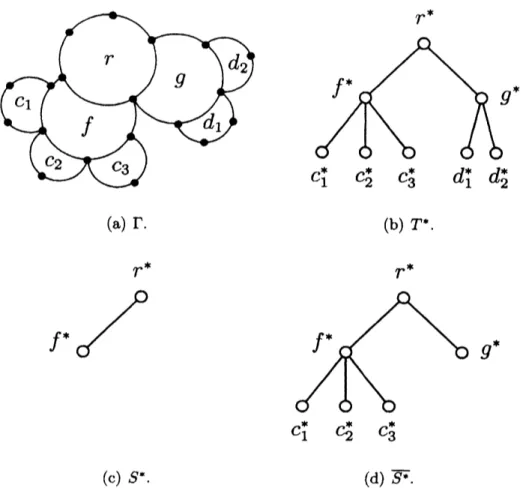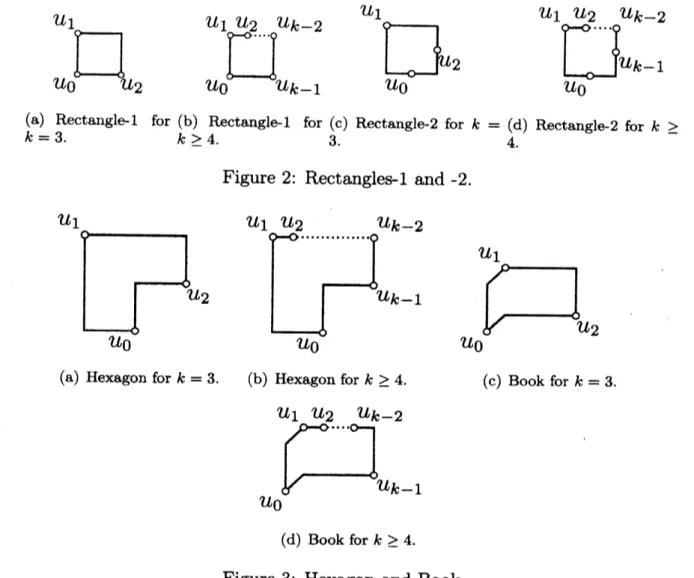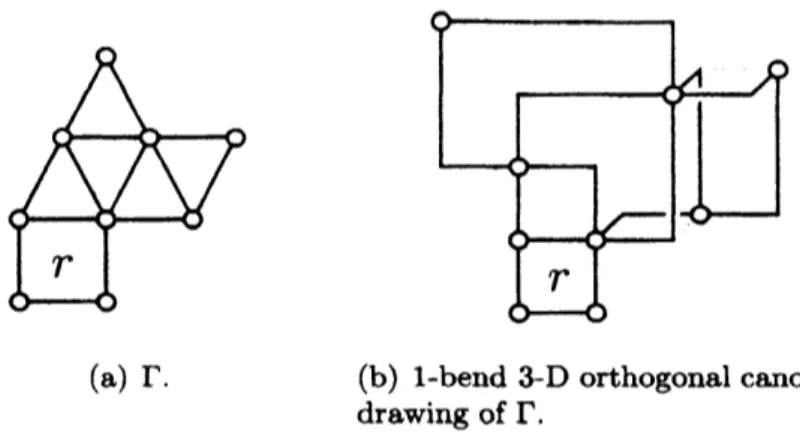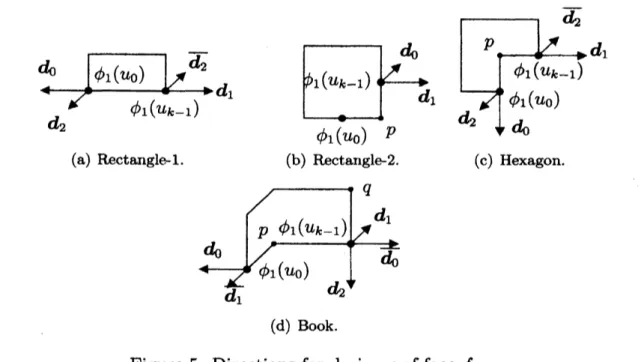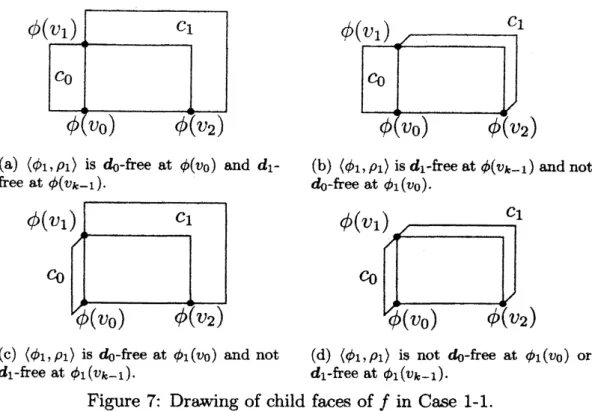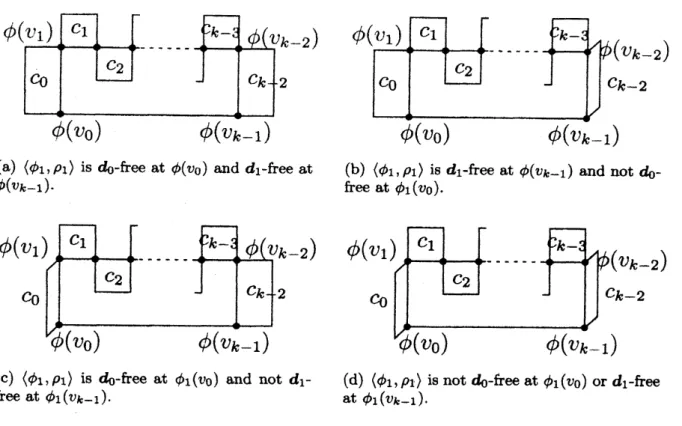On
the
Three-Dimensional
Orthogonal
Drawing
of
Outerplanar Graphs (Extended
Abstract)
Satoshi
Tayu
Takuya
Oshima
Shuichi Ueno
Department of
Communications
and Integrated Systems
Tokyo
Institute of Technology, Tokyo 152-8550-S3-57, Japan
Abstract
It has beenknownthat every series-paralle16-graph has a2-bend 3-D
orthog-onal drawing, while it has been open whether every series-paralle16-graph has a
l-bend $3arrow D$ orthogonal drawing. We show in this paper that every outerplanar
5-graph has a l-bend 3-D orthogonal drawing.
1
Introduction
We consider the problem ofgenerating orthogonal drawings ofgraphs inthe space. The
problem has obvious applications in the design of 3-D VLSI circuits and optoelectronic
integrated systems [3, 5].
Throughout thispaper, we considersimpleconnected graphs $G$withvertexset $V(G)$
and edge set $E(G)$. We denote by $d_{G}(v)$ the degree ofavertex $v$ in $G$, and by $\Delta(G)$ the
maximum degree ofa vertex ofG. $G$ is called
a
k-graph if $\Delta(G)\leq k$. The connectivityof a graph is the minimum number of vertices whose removal results in a disconnected
graph or a single vertex graph. A graph is said to be k-connected ifthe connectivity of
the graph is at least $k$.
It iswell-known that every graph
can
bedrawn inthe spaceso
that its edges intersectonly at their ends. Such
a
drawing ofa
graph $G$ is called a 3-D drawingof $G$.
A graphis said to be planar if it can be drawn in the plane so that its edges intersect only at
their ends. Such a drawing of a planar graph $G$ is called
a
2-D drawing of$G$.
A 3-D orthogonal drawing of a graph $G$ is a 3-D drawing such that each edge is
drawn by a sequence of contiguous axis-parallel line segments. Notice that a graph $G$
has a 3-D orthogonal drawing only if $\Delta(G)\leq 6$
.
A 3-D orthogonal drawing withno
more
than $b$ bends per edge is calleda
bbend 3-D orthogonal drawing.Eades, Symvonis, and Whitesides [2], and Papakostas and Tollis [6] showed that
every 6-graph has a 3-bend $3arrow D$ orthogonal drawing. Eades, Symvonis, and 珂珂
hite-sides [2] also posed
an
interesting open question of whether every 6-graph has a 2-bend3-D orthogonal drawing. Wood [8] showed that every 5-graph hasa 2-bend 3-D
orthog-onal drawing. Tayu, Nomura, and Ueno [7] showed that every series-paralle16-graph
has a 2-bend 3-D orthogonal drawing. Moreover, Nomura, Tayu, and Ueno [4] showed that every outerplanar 6-graph has
a
0-bend 3-D orthogonal drawing if and only if itcontains no triangle as a subgraph, while Eades, Stirk, and Whitesides [1] proved that
it is NP-complete to decide if a given 5-graph has a 0-bend 3-D orthogonal drawing.
Tayu, Nomura, and Ueno [7] also posed
an
interesting open question of whether every$series- parallel6arrow graph$ has
a
l-bend 3-D orthogonal drawing.We shown in this paper the following theorem.
Theorem I Every outerplanar 5-graph has
a
l-bend 3-D orthogonal dmwing.The proof of Theorem 1 is constructive and provides
a
polynomial time algorithm togenerate such
a
drawing foran
outerplanar 5-graph. It is still open whether everyseries-paralle16-graph has
a
l-bend 3-D orthogonal drawing.2
Preliminaries
A 2-D drawing of
a
planar graph $G$ is regardedas a
graph isomorphic to $G$, and referredto
as
a
plane graph. A plane graph partitions the rest of the plane into connectedregions. A
face
is a closure of such a region. The unbounded region is referred toas
the extemal
face.
We denote the boundary ofa face $f$ of a plane graph $\Gamma$ by $b(f)$. If$\Gamma$is 2-connected then $b(f)$ is a cycle of $\Gamma$.
Given
a
plane graph $\Gamma$, wecan
define another graph $\Gamma$‘as
follows: corresponding toeach face $f$ of $\Gamma$ there is a vertex $f^{*}$ of$\Gamma^{*}$, and corresponding to each edge
$e$ of$\Gamma$ there
is an edge $e^{*}$ of $\Gamma^{*}$; two
vertices $f^{*}$ and $g^{*}$ are joined by the edge $e^{*}$ in $\Gamma$“ if and only
if the edge $e$ in $\Gamma$ lies
on
thecommon
boundary of faces$f$ and $g$ of $\Gamma$. $\Gamma^{*}$ is called the
$(geomet_{7}\dot{v}carrow)dual$of$\Gamma$.
A graph is said to be outerplanar if it has a 2-D drawing such that every vertexlies
on the boundary of the external face. Such a drawing of an outerplanar graph is said
to be outerplane. It is well-known that
an
outerplanar graph isa
series-parallel graph.Let $\Gamma$ be
an
outerplane graphwith the external face$f_{0}$, and $\Gamma^{*}-f_{0}^{*}$ be
a
graph obtainedfrom $\Gamma$‘ by deleting vertex
$f_{0}^{*}$ together with the edges incident to $f_{0}^{*}$. It is easy to
see
that if $\Gamma$ is an outerplane graph then
$\Gamma^{*}-f_{0}^{*}$ is a forest. In particular, an outerplane
graph $\Gamma$ is 2-connected if and only if
$\Gamma‘-f_{0}^{*}$ is a tree.
3
2-Connected
Outerplanar Graphs
We first consider the
case
when $G$ is 2-connected. Let $G$ bea
2-connected outerplanar5-graph and $\Gamma$ be an outerplane graph isomorphic to $G$. Since $\Gamma$ is 2-connected, $\tau*=$
$\Gamma^{*}-f_{0}^{*}$ is
a
tree. A vertex $r^{*}$ of $\tau*$ is designatedas
a
root, and $T$“ is consideredas
arooted tree. If $l^{*}$ is a leaf of $\tau*$ then $l$ is called a
leaf
face
of $\Gamma$. If $g^{*}$ is a child of $f^{*}$in $\tau*$ then $f$ is called the parent
face
of$g$, and $g$ is called
a
childface
of $f$ in $\Gamma$. Theunique edge in $b(f)\cap b(g)$ is called the base of$g$
.
We choose $r^{*}$so.
that $b(r)\cap b(f_{0})\neq\emptyset$,and any edge in $b(r)\cap b(f_{0})$ is defined
as
the base of$r$. Let $S^{*}$ be arooted subtree of$\tau*$with root $r^{*}$. If $S^{*}$ is consisting ofjust $r^{*}$ then $S^{*}$ is denoted by $r^{*}$
.
$\Gamma[S"]$ is a subgraphof$\Gamma$ induced by the vertices
on
boundaries of faces of $\Gamma$corresponding to the vertices of$S^{*}$
.
It should be noted that $\Gamma[S^{*}]$ isa
2-connected outerplane graph. Let $f^{*}$ bea
vertexin $V(T^{*})-V(S^{*})$ which is
a
child of$p^{*}\in V(S^{*})$.
$S^{*}+f^{*}$ isa
subtree of $\tau*$ obtainedfrom $S^{*}$ by adding $f^{*}$ and edge $(f^{*},p^{*})$
.
Let $\overline{s*}$$r^{*}$ $c_{1}^{*}$ $c_{2}^{*}$ $c_{3}^{*}$ $d_{1}^{*}d_{2}^{*}$ (a) $\Gamma$. (b) $\tau*$. $r^{*}$ $r^{*}$ $c_{1}^{*}$ $c_{2}^{*}$ $c_{3}^{*}$ (c) $S^{*}$
.
(d) $\overline{S^{s}}$.Figure 1: Example of an outerplanae graph $\Gamma$, rooted tree $\tau*$, subtrees $S^{*}$ and $\overline{s*}$ of
$\tau*$.
induced by the vertices of $S^{*}$ and the children of the vertices of $S^{*}$
.
Fig. 1 showsan
example ofan outerplane graph $\Gamma$, rooted tree $\tau*$, and rooted subtrees $S^{*}$ and $\overline{s*}$.
For any face $f$ of$\Gamma,$ $b(f)$ is a cycle since $\Gamma$ is 2-connected. Let
$V(b(f))$ $=$ $\{u_{i}|0\leq i\leq k-1\}$,
$E(b(f))$ $=$ $\{e_{0}=(u_{0}, u_{k-1})\}\cup\{e_{i+1}=(u_{i}, u_{i+1})|0\leq i\leq k-2\}$
where $e_{0}$ is the base of $f$. A l-bend 3-D orthogonal drawing of $b(f)$ is said to be
canonicalif$b(f)$ is drawn as one of the following four configurations.
Configuration 1 (Rectangle-l) : If $k=3$ then only $e_{2}$ has a bend
as
shown inFig. 2(a). If $k\geq 4$ then every edge has no bend, and $u_{1},$ $u_{2},$ $\ldots,$$u_{k-2}$
are
drawnon a side ofa rectangle as shown in Fig. 2(b).
Configuration 2 (Rectangle-2) : If $k=3$ then every edge has a bend, and $u_{1}$ is at
a corner of a rectangle
as
shown in Fig. 2(c). If $k\geq 4$ then only $e_{0}$ and $e_{1}$ have abend, $u_{1},$ $u_{2},$ $\ldots,$$u_{k-2}$
are
drawn on aside of a rectangle, and $u_{0}$ and $u_{k-1}$are
onanother difTerent sides of the rectangle as shown in Fig. 2(d).
Conflguration 3 (Hexagon) : If $k=3$ then every edge has a bend
as
shown inFig. 3(a). If $k\geq 4$ then only $e_{0}$ and $e_{1}$ have a bend, and $u_{1},$ $u_{2},$ $\ldots,$$u_{k-2}$
are
ona
$u_{1}u_{2}$ $u_{k-2}$
$\infty$
$u_{0}$ $u_{k-1}$
(a) Rectangle-l for (b) Rectangle-l for (c) Rectangle-2 for $k=(d)$ Rectangle-2 for $k\geq$
$k=3$. $k\geq 4$. 3. 4.
Figure 2: Rectangles-l and-2.
(a) Hexagon for $k=3$. (b) Hexagonfor $k\geq 4$. (c) Book for $k=3$.
(d) Bookfor $k\geq 4$
.
Figure 3: Hexagon and Book.
Conflguration 4 (Book) : A book is obtained from a rectangle by bending at a line
segment, called the spine, parallel to a side of the rectangle. If $k=3$ then every
edge has a bend
as
shown in Fig. 3(c). If $k\geq 4$ then only $e_{0},$ $e_{1}$, and $e_{k-1}$ have abend, and $u_{1},$ $u_{2},$
$\ldots,$ $u_{k-2}$
are on a
side ofa
bookas
shown in Fig. 3(d).A drawing of $\Gamma$ is said to be canonical if every face is drawn
canonically. Fig. 4 shows
an
example of an outerplane graph $\Gamma$, and a l-bend 3-D orthogonal canonicaldrawing of $\Gamma$.
Roughly speaking, we will show that if$\Gamma[\overline{S^{*}}]$ has a l-bend 3-D orthogonal canonical
drawing then $\Gamma[S*\neg+f^{*}$ also has a l-bend 3-D orthogonal canonical drawing, where $f^{*}$
is
a
leaf of $\overline{s*}$. The following theoremimmediately follows by induction.
Theorem II A 2-connected outerplanar 5-graph has a l-bend 3-D orthogonal drawing.
3.1
Proof of Theorem
II
For
a
grid point $p=(p_{x},p_{y},p_{z})$ anda
vector $v=(v_{x}, v_{y}, v_{z})$, let $p+v$ be the grid point(a) $\Gamma$. (b) l-bend $3arrow D$ orthogonal canonical
drawingof$\Gamma$
.
Figure 4: Example of $\Gamma$ and l-bend 3-D orthogonal canonical drawing of $\Gamma$.
$0,0))e_{y}=(0,1,0),$ $e_{z}=(0,0,1)$, and $D=\{e_{x}, e_{y}, e_{z},\overline{e_{x}},\overline{e_{y}}, \overline{e_{z}}\}$
.
Every vector in $D$ iscalled a direction.
A 3-D orthogonal drawing of a plane graph $\Gamma$
can
be regardedas
a pair $\langle\phi,$$\rho\rangle$ of$onearrow to$
-one
mappings $\phi$ : $V(\Gamma)arrow \mathbb{Z}^{3}$ and $\rho$which maps edges $(u, v)$ tointemallydisjointpaths on the 3-D grid $\mathcal{G}$ connecting $\phi(u)$ and $\phi(v)$. For a direction $d\in D$ and a vertex
$v\in V(\Gamma),$ $\langle\phi,$$\rho\rangle$ is said to be
d-free
at $\phi(v)$ if $\rho(e)$ does not contain the edge of $\mathcal{G}$connecting $\phi(v)$ and $\phi(v)+d$.
Let $\Gamma$ be a 2-connected outerplane graph, and $\langle\phi,$$\rho\rangle$ be
a
3-D orthogonal canonicaldrawing of $\Gamma$. Let $f$ be
a
leaf face of $\Gamma$, and$V(b(f))$ $=$ $\{u_{i}|0\leq i\leq k-1\}$,
$E(b(f))$ $=$ $\{(u_{0}, u_{k-1})\}\cup\{(u_{i}, u_{f+1})|0\leq i\leq k-2\}$,
where $(u_{0}, u_{k-1})$ is the base of$f$. We define three unit vectors $d_{0}(f, u_{0}),$ $d_{1}(f, u_{0})$, and
$d_{2}(f, u_{0})$
as
follows:$\bullet$ If $f$ is drawn
as
a rectangle-l, we define that $d_{C}(f, u_{0})$ is the unit vector directedfrom $\phi(u_{k-1})$ to $\phi(u_{0}),$ $d_{1}(f, u_{0})=\overline{d_{0}(f,u_{0})}$, and $d_{2};(f, u_{0})$ is a unit vector
orthog-onal to the rectangle.
$\bullet$ If $f$ is drawn
as a
rectangle-2, let$p$ be the bend of base $(u_{0}, u_{k-1})$.
We define that$d_{1}(f, u_{0})$ is
a
unit vector orthogonal to the rectangle, and $d_{0}(f, u_{0})$ is the unitvector directed from $\varphi(u_{0})$ to $p$.
$\bullet$ If $f$ is drawn
as
a hexagon, let $p$ be the bend of base $(u_{0}, u_{k-1})$. We definethat $d_{0}(f, u_{0})$ is the unit vector directed from $p$ to $\phi(u_{0}),$ $d_{1}(f, u_{0})$ is the unit
vector directed from $p$ to $\phi(u_{k-1})$. and $d_{2}(f, u_{0})$ is a unit vector orthogonal to the
hexagon.
$\bullet$ If $f$ is drawn
as
a book, let $p$ be the bend of base $(u_{0}, u_{k-1})$.
We define that$d_{t}(f, u_{0})$ is the unit vector directed from $\phi(u_{karrow 1})$ to $p,$ $d_{1}(f, u_{0})$ is the unit vector
directed from $\phi(u_{0})$ to $p$, and $d_{2}(f, u_{0})$ is the unit vector directed from the bend
$q$ of edge $(u_{k-2}, u_{k-1})$ to $\phi(u_{k-1})$
.
Let $\langle\phi,$$\rho\rangle$ be a l-bend 3-D orthogonal canonical drawing of
$\Gamma$. $\langle\phi,$$\rho\rangle$ is said to be
Condition 1 : $f$ is drawn
as
a rectangle-l or hexagon, and$\bullet$ if $d_{\Gamma}(u_{0})\leq 4$ then $\langle\phi,$$\rho\rangle$ is $d_{0}(f, u_{0})$-free
or
$d_{2}(f, u_{0})$-free at $\phi(u_{0})$,
1 if $d_{\Gamma}(u_{k-1})\leq 4$ then $\langle\phi,$$\rho\rangle$ is $d_{1}(f, u_{0})$-free or $\overline{d_{2}(f,u_{0})}$-free at $\phi(u_{k-1})$; (See
Fig. 5(a) and $(c).)$
Condition 2 : $f$ is drawn
as
a rectangle-2, and$\bullet d_{\Gamma}(u_{0})=5$,
$\bullet$ $\langle\phi,$$\rho\rangle$ is $d_{\varphi}(f, u_{0})$-free at $\phi(u_{k-1})$,
$\bullet$ if $d_{\Gamma}(u_{k-1})\leq 3$ then $\langle\phi,$$\rho\rangle$ is $d_{1}(f, u_{0})$-free at $\phi(u_{k-1})$. (See Fig. $5(b).$)
Condition 3 : $f$ is drawn
as
a book, and$\bullet$ if $d_{\Gamma}(u_{0})\leq 4$ then $\langle\phi,$$\rho\rangle$ is $d_{0}(f, u_{0})$-free
or
$\overline{d_{1}(f,u_{0})}$-free at $\phi(u_{0})$,$\bullet$ if $d_{\Gamma}(u_{k-1})\leq 4$ then $\langle\phi,$$\rho\rangle$ is $d_{1}(f, u_{0})$-free
or
$\overline{d_{0}(f,u_{0})}$-free at $\phi(u_{k-1})$, $\bullet$ if $d_{\Gamma}(u_{0})\leq 4,$ $d_{\Gamma}(u_{k-1})\leq 4,$ $\langle\phi,$$\rho\rangle$ is not $d_{0}(f, u_{0})$-free at $\phi(u_{0})$, and $\langle\phi,$$\rho\rangle$is not $d_{1}(f, u_{0})$-free at $\phi(u_{k-1})$ then $\langle\phi,$$\rho\rangle$ is $d_{2}(f, u_{0})$-free at $\phi(u_{k-1})$, and
$d_{\Gamma}(u_{k-1})=4$,
$\bullet$ spine except for their ends is not used in the drawing; (See Fig. $5(d).$)
(a) Rectangle 1. (b) Rectangle-2. (c) Hexagon.
(d) Book.
Figure 5: Directions for draiwng offace $f$
.
$\langle\phi,$$\rho\rangle$ is called a l-bend 3-D orthogonal$\tau$-drautng of$\Gamma$ if $\langle\phi,$$\rho\rangle$ is addmissible for every
leaf face of$\Gamma$
.
In order to prove Theorem II, it suffices to prove the following.Proof.
Let $G$ be a 2-connected outerplanar 5-graph, $\Gamma$ bea
outerplane graphisomor-phic to $G$, and $T”=\Gamma"-f_{0}^{*}$ be
a
tree rooted at $r^{*}$. Weprove the theorem by induction.The basis ofthe induction is stated
as
follows.Lemma 1 $r_{r}\coprod^{*}$ has
a
l-bend 3-D orthogonal $\tau$-draunng.Proof of
Lemma 1 Let$V(b(r))$ $=$ $\{v_{i}|0\leq i\leq k-1\}$,
$E(b(r))$ $=$ $\{(v_{0}, v_{k-1})\}\cup\{(v_{i}, v_{i+1})|0\leq i\leq k-2\}$,
where $(v_{0}, v_{k-1})$ is the base of $r$
.
Let $c_{i}$ bea
child face of $r$ with base $(v_{i}, v_{i+1})$ for$0\leq i\leq k-2$, if any. Let $\langle\phi,$$\rho\rangle$ be a l-bend 3-D orthogonal canonical drawing
of $r_{r}\prod^{*}$
as
shown in Fig. 6, where $c_{i}$ is drawnas
rectangle-l, if any. Since$\langle\phi,$$\rho\rangle$ is
$d_{0}(c_{0}, v_{0})$-free at $\phi(v_{0})$ and $d_{1}(c_{0}, v_{0})$-free at $\phi(v_{1}),$ $\langle\phi,$$\rho\rangle$ satisfies Condition 1 for $c_{0}$
.
If$k=3$, by taking $d_{2}(c_{1}, v_{1})=e_{z},$ $\langle\phi,$$\rho\rangle$ is $d_{2}(c_{1}, v_{1})$-free at $\phi(v_{1})$ and $d_{1}(c_{1}, v_{1})$-free at
$\phi(v_{2})$
.
Therefore, $\langle\phi,$$\rho\rangle$ also satisfies Condition 1 for $c_{1}$, and we conclude that $\langle\phi,$$\rho\rangle$
is a l-bend 3-D orthogonal $\tau$-drawing of $r_{r}\prod^{*}$
.
If $k\geq 4$, by taking $d_{2}(q, v_{i})=e_{z}$ for $1\leq i\leq k-3,$ $\langle\phi,$$\rho\rangle$ is $d_{q}(q, v_{i})$-free at $\phi(v_{i})$ and $d_{\eta}(q, v_{i})$-free at $\phi(v_{i+1})$. Thus,$\langle\phi,$$\rho\rangle$
satisfies Condition 1 for $c_{i}(1\leq i\leq k-3)$. Similarly, by taking $d_{2}(c_{k-2}, v_{k-2})=\overline{e_{z}}$,
$\langle\phi,$$\rho\rangle$ is $d_{Q}(c_{k-2}, v_{k-2})$-free at $\phi(v_{k-2})$ and $d_{2}(c_{k-2}, v_{k-2})$-free at $\phi(v_{k-1})$. Thus,
$\langle\phi,$$\rho\rangle$
satisfies Condition 1 for $c_{k-2}$. So,
we
conclude that $\langle\phi,$$\rho\rangle$ is a l-bend 3-D orthogonal $\tau$-drawing of$\Gamma r^{*}\prod$.
$\square$
(a) $k=3$. (b) $k\geq 4$
.
Figure 6: Drawing of initial
case.
Let $S^{*}$ be a rooted subtree of $\tau*$ with root $r$‘. The following lemma is used to
prove the inductive step. The proof is immediate from the definition ofthe l-bend $3arrow D$
orthogonal $\tau$-drawing.
Lemma 2 Let $\langle\phi_{1},$ $\rho_{1}\rangle$ be a l-bend 3-D orthogonal $\tau$-draunng
of
$\Gamma[\overline{S^{*}}],$ $f^{*}$ bea
leaf
of
$\overline{S^{*}}$,and $\langle\phi_{2},$ $\rho_{2}\rangle$ be a l-bend 3-D orthogonal drawing
of
$\Gamma[S^{*}+f^{*}]$, obtainedfrom
$\langle\phi_{1},$$\rho_{1}\rangle$ by addingcanonical
dmrningsof
the childfaces
of
$f$. If
$\langle\phi_{2},$$\rho_{2}\rangle$ is $a\underline{dmissib}le$
for
every childface of
$f$ then $\langle\phi_{2},$ $\rho_{2}\rangle$ is a l-bend 3-D orthogonal drawingof
$\Gamma[S^{*}+f^{*}]$. $\square$The inductive step is
stated as
follows.Lemma 3
If
$\Gamma[\overline{S^{*}}]$ has a l-bend 3-D orthogonal $\tau$-drawing then $\Gamma[\overline{S^{*}+f^{*}}]$ also has a(a) $(\phi_{1},\rho_{1}\rangle$ is $d_{0}$-kee at $\phi(v_{0})$ and $d_{1}-$
ffee at $\phi(v_{k-1})$
.
(b) $\langle\phi_{1},\rho_{1}\rangle$ is$d_{1}$-free at $\phi(v_{k-1})$ andnot $d_{0}$-freeat $\phi_{1}(v_{0})$.
(c) $\langle\phi_{1,\beta 1}\rangle$ is do-hee at $\phi_{1}(v_{0})$ and not (d) $\langle\phi_{1},\rho_{1}\rangle$ is not $d_{0^{-}}hee$ at $\phi_{1}(v_{0})$ or $d_{1}$-free at $\phi_{1}(v_{k-1})$
.
$d_{1}$-free at $\phi_{1}(v_{k-1})$.
Figure 7: Drawing of child faces of $f$ in Case $1arrow 1$.
Proof of
Lemma 3 (scketch) Let $\Lambda_{1}=\Gamma[\overline{S^{*}}]$ and $\Lambda_{2}=\Gamma[\overline{S^{*}+f^{*}}]$, and let $\langle\phi_{1},$$\rho_{1}\rangle$ bea l-bend $3-D$ orthogonal $\tau$-drawing of $\Lambda_{1}$. We will construct a l-bend $3-D$ orthogonal
$\tau$-drawing $\langle\phi_{2},$ $\rho_{2}\rangle$ of$\Lambda_{2}$
.
Let$V(b(f))$ $=$ $\{v_{i}|0\leq i\leq k-1\}$,
$E(b(f))$ $=$ $\{e_{0}=(v_{0}, v_{k-1})\}\cup\{e_{i+1}=(v_{i}, v_{i+1})|0\leq i\leq k-2\}$,
where $e_{0}=(v_{0}, v_{k-1})$ is the base of $f$. We distinguish four
cases
depending on theconfiguration of $f$ by $\langle\phi_{1},$$\rho_{1}\rangle$
.
Case 1. $f$ is drawn
as
a rectangle-l:Without loss of generality, we
assume
that $d_{0}(f, v_{0})=\overline{e_{x}},$ $d_{2}(f, v_{0})=\overline{e_{y}}$, andz-coordinate of $\phi_{1}(v_{1})$ is larger than that of $\phi_{1}(v_{0})$. Let $c_{i}$ be
a
child face of $f$with base $(v_{i}, v_{i+1})$ for $0\leq i\leq k-2$, if any. We further distinguish three
cases.
Case 1-1. $k=3$;Since $\langle\phi_{1},$ $\rho_{1}\rangle$ is a l-bend $3arrow D$ orthogonal $\tau$-drawing, we distinguish four
cases
depending
on
free directions.Case 1-1-1. $\langle\phi_{1},$$\rho_{1}\rangle$ is $d_{t}(f, v_{0})$-free at $\phi_{1}(v_{0})$ and $d_{1}(f, v_{0})$-free at $\phi_{1}(v_{2})$:
Since $\langle\phi_{1},$$\rho_{1}\rangle$ is $d_{0}(f, v_{0})$-free at $\phi_{1}(v_{0})$ and $d_{1}(f, v_{0})$-free at $\phi_{1}(v_{2})$, canonical
drawings of $c_{0}$ and $c_{1}$
can
be added to $\langle\phi_{1},$$\rho_{1}\rangle$as
shown in Fig. 7(a), if any. Let$\langle\phi_{2},$ $\rho_{2}\rangle$ be the resultant l-bend 3-D orthogonal canonical drawing. If $c_{0}$ exists
and $d_{\Lambda_{2}}(v_{0})\leq 4$ then $\langle\phi_{2},\rho_{2}\rangle$ is$\overline{e_{z}}$-free
or
$e_{y}$-free at $\phi_{2}(v_{0})$, since $d_{\Lambda_{2}}(v_{0})\leq 4$ (seeFig. $7(a))$. Since $d_{0}(c_{0}, v_{0})=\overline{e_{z}}$ by definition, by taking $d_{2}(c_{0}, v_{0})=e_{y},$ $\langle\phi_{2},$$\rho_{2}\rangle$
is $d_{0}(c_{0}, v_{0})$-free
or
$d_{2}(c_{0}, v_{0})$-free at $\phi_{2}(v_{0})$, and $\langle\phi_{2},$$\rho_{2}\rangle$ satisfies Condition 1 for$c_{0}$. If$c_{1}$ exists and $d_{\Lambda_{2}}(v_{2})\leq 4$ then $\langle\phi_{2},$$\rho_{2}\rangle$ is $\overline{e_{z}}$-free or $\overline{e_{y}}$-free at $\phi_{2}(v_{2})$
.
Since$d_{1}(c_{1}, v_{1})=\overline{e_{z}}$ by definition, by taking $d_{2}(c_{1}, v_{1})=e_{y},$ $\langle\phi_{2},$ $\rho_{2}\rangle$ is $d_{1}(c_{1}, v_{1})$-free
$\langle\phi_{2},$$\rho_{2}\rangle$ is $d_{2}(c_{1}, v_{1})$-free at $\phi_{2}(v_{1})$. Thus by Lemma 2, we conclude that $\langle\phi_{2},$ $\rho_{2}\rangle$
is
a
l-bend 3-D orthogonal $\tau$-drawing of $\Gamma[\overline{S^{*}+f^{*}}]$.Case 1-1-2. $\langle\phi_{1},$$\rho_{1}\rangle$ is $d_{0}(f, v_{0})$-free at $\phi_{1}(v_{0})$ and not $d_{1}(f, v_{0})$-free at $\phi_{1}(v_{2})$:
In this case, $\langle\phi_{1},$ $\rho_{1}\rangle$ is $\overline{d_{2}(f,v_{0})}$-free at $\phi_{1}(v_{2})$, since $\langle\phi_{1},$ $\rho_{1}\rangle$ satisfies Condition 1
for $f$. Let $\langle\phi_{2},$ $\rho_{2}\rangle$ be a l-bend 3-D orthogonal canonical drawing obtained from $\langle\phi_{1},$$\rho_{1}\rangle$ by adding canonical drawings of$c_{O}$ and $c_{1}$
as
shown in Fig. 7(b), ifany. Bythe similar arguments to Case $1arrow 1- 1$,
we
can
see
that $\langle\phi_{2},$$\rho_{2}\rangle$ satisfies Condition1 for $c_{0}$, if any. If $c_{1}$ exists and $d_{\Lambda_{2}}(v_{2})\leq 4$ then $\langle\phi_{2},$$\rho_{2}\rangle$ is $\overline{e_{z}}$-free at $\phi_{2}(v_{2})$, since $\langle\phi_{1},$$\rho_{1}\rangle$ is not $e_{x}$-free at $\phi_{1}(v_{2})$ and $d_{\Lambda_{2}}(v_{2})\leq 4$
.
Also, $\langle\phi_{2},$ $\rho_{2}\rangle$ is $e_{z}$-free at $\phi_{2}(v_{1})$.Since $d_{0}(c_{1}, v_{1})=e_{z}$ and $d_{1}(c_{1}, v_{1})=e_{x}$ by definition, $\langle\phi_{2},$ $\rho_{2}\rangle$ satisfies Condition
3 for $c_{1}$
.
Thus by Lemma 2,we
conclude that $(\phi_{2},$$\rho_{2}\rangle$ isa
l-bend 3-D orthogonal$\tau$-drawing of$\Gamma[\overline{S^{*}+f^{*}}]$.
Case 1-1-3. $\langle\phi_{1},$$\rho_{1}\rangle$ is not $d_{0}(f, v_{0})$-free at $\phi_{1}(v_{0})$ and $d_{1}(f,v_{0})$-kee at $\phi_{1}(v_{2})$:
In this case, $\langle\phi_{1},$$\rho_{1}\rangle$ is $d_{2}(f, v_{0})$-free at $\phi_{1}(v_{0})$, since $\langle\phi_{1},$ $\rho_{1}\rangle$ satisfies Condition 1
for $f$. Let $\langle\phi_{2},$$\rho_{2}\rangle$ be a l-bend 3-D orthogonal canonical drawing obtained from $\langle\phi_{1},$ $\rho_{1}\rangle$ by adding canonical drawings of $c_{0}$ and $c_{1}$
as
shown in Fig. 7(c), if any.If $d_{\Lambda_{2}}(v_{0})\leq 4$ and $c_{0}$ exists then $\langle\phi_{2},$$\rho_{2}\rangle$ is $\overline{e_{z}}$-free at $\phi_{2}(v_{0})$, since $\langle\phi_{1},$$\rho_{1}\rangle$ is not $\overline{e_{x}}$-free at $\phi_{1}(v_{0})$ and $d_{\Lambda_{2}}(v_{0})\leq 4$
.
Thenby taking $d_{2}(c_{0}, v_{0})=e_{x},$ $\langle\phi_{2},$$\rho_{2}\rangle$ satisfiesCondition 1 for $c_{0}$, since $\langle\phi_{2},$ $\rho_{2}\rangle$ is $\overline{d_{2}(c_{0},v_{0})}$-free at $\phi_{2}(v_{1})$
.
Also, by the similararguments to Case $1arrow 1- 1$, we
can
see
that $\langle\phi_{2},$$\rho_{2}\rangle$ satisfies Condition 1 for $c_{1}$, ifany. Thus by Lemma 2,
we
conclude that $\langle\phi_{2},$ $\rho_{2}\rangle$ isa
l-bend 3-D orthogonal $\tau$-drawing of $\Gamma[\overline{S^{*}+f^{*}}]$.
Case 1-1-4. $\langle\phi_{1},$ $\rho_{1}\rangle$ is not $d_{0}(f, v_{0})$-free at $\phi_{1}(v_{0})$ nor $d_{1}(f, v_{0})$-free at $\phi_{1}(v_{2})$:
In this case, $\langle\phi_{1},$ $\rho_{1}\rangle$ is $d_{Q}(f, v_{0})$-free at $\phi_{1}(v_{0})$ and $d_{2}(f, v_{0})$-free at $\phi_{1}(v_{2})$, since
$\langle\phi_{1},$ $\rho_{1}\rangle$ satisfies Condition 1 for$f$. Let $\langle\phi_{2},$ $\rho_{2}\rangle$ be
a
l-bend 3-D orthogonalcanon-ical drawing obtained from $\langle\phi_{1},$ $\rho_{1}\rangle$ by adding canonical drawings of $c_{0}$ and $c_{1}$ as
shown in Fig. 7(d), if any. Then by similar arguments to Case 1-1-3 and Case 1-1-2, we can see that $\langle\phi_{2},$$\rho_{2}\rangle$ satisfies Conditions 1 and 3 for $c_{0}$ and $c_{1}$,
respec-tively. Thus by Lemma 2,
we
conclude that $\langle\phi_{2},$ $\rho_{2}\rangle$ isa
l-bend 3-D orthogonal $\tau$-drawing of$\Gamma[\overline{S^{*}+f^{*}}]$.Case 1-2. $k\geq 4,$ $k$ is
even:
Since $\langle\phi_{1},$ $\rho_{1}\rangle$ is a l-bend
&D
orthogonal $\tau$-drawing,we
distinguish fourcases
depending
on
free directions.Case 1-2-1. $\langle\phi_{1},$$\rho_{1}\rangle$ is $d_{0}(f, v_{0})$-free at $\phi_{1}(v_{0})$ and $d_{1}\{f,$$v_{k-2})$-free at $\phi_{1}(v_{k-1})$:
Since $\langle\phi_{1},$ $\rho_{1}\rangle$ is $d_{0}(f, v_{0})$-free at $\phi_{1}(v_{0})$ and $d_{1}(f, v_{0})$-free at $\phi_{1}(v_{k-1})$, canonical
drawings of$c_{i}(0\leq i\leq k-2)$
can
beadded to $\langle\phi_{1},$$\rho_{1}\rangle$as
shown in Fig. 8(a), if any.Let $\langle\phi_{2},$$\rho_{2}\rangle$ bethe resultant l-bend 3-D orthogonal canonical drawing. If$c_{0}$ exists
and $d_{\Lambda_{2}}(v_{0})\leq 4$ then $\langle\phi_{2},$$\rho_{2}\rangle$ is $\overline{e_{z}}$-free or $e_{y}$-free at $\phi_{2}(v_{0})$, since $d_{\Lambda_{2}}(v_{0})\leq 4$ (see
Fig. $8(a))$
.
Since $d_{0}(c_{0}, v_{0})=\overline{e_{z}}$by definition, by taking $d_{2}(c_{0}, v_{0})=e_{y},$ $\langle\phi_{2},$$\rho_{2}\rangle$ is$d_{0}(c_{0}, v_{0})$-free or $d_{2}(c_{0}, v_{0})$-free at $\phi_{2}(v_{0})$. Also, $\langle\phi_{2},$$\rho_{2}\rangle$ is$\overline{d_{2}(c_{0},v_{0})}$-free at $\phi_{2}(v_{1})$.
Therefore, $\langle\phi_{2},$ $\rho_{2}\rangle$ satisfies Condition 1 for $c_{0}$. If $c_{k-2}$ exists and $d_{\Lambda_{2}}(v_{k-1})\leq 4$
then $\langle\phi_{2},$ $\rho_{2}\rangle$ is $\overline{e_{z}}$-free
or
$\overline{e_{y}}$-free at $\phi_{2}(v_{k-1})$. Since $d_{1}(c_{k-2}, v_{k-2})=\overline{e_{z}}$ bydefini-tion, by taking$d_{2}(c_{k-2}, v_{k-2})=e_{y},$ $\langle\phi_{2},$ $\rho_{2}\rangle$ is $d_{1}(c_{k-2}, v_{k-2})$-free
or
$d_{2}(c_{k-2}, v_{k-2})arrow$free at $\phi_{2}(v_{k-1})$
.
Thus, $\langle\phi_{2},$ $\rho_{2}\rangle$ satisfies Condition 1 for $c_{k-2}$, since $\langle\phi_{2},$ $\rho_{2}\rangle$ is$d_{Q}(c_{k-2}, v_{k-2})$-free at $\phi_{2}(v_{k-2})$
.
Since $\langle\phi_{2},$$\rho_{2}\rangle$ is $\overline{e_{y}}$-free at $\phi_{2}(v_{i})$ and $e_{y}$-free at(a) $\langle\phi_{1,\rho_{1}}\rangle$ is do-kee at $\phi(v_{0})$ and $d_{1}- ffee$ at (b) $\langle\phi_{1\beta 1}\rangle$ is $d_{1}$-free at $\phi(v_{k-1})$ and not $d_{0^{-}}$
$\phi(v_{k-1})$. free at $\phi_{1}(v_{0})$
.
(c) $\langle\phi_{1},$$\rho_{1}\rangle$ is $d_{0}$-kee at $\phi_{1}(v_{0})$ and not $d_{1^{-}}$ (d) $\langle\phi_{1},$$\rho_{1}\rangle$ is not $d_{0}$-freeat $\phi_{1}(v_{0})$ or $d_{1}$-free
free at $\phi_{1}(v_{k-1})$. at $\phi_{1}(v_{karrow 1})$
.
Figure 8: Drawing of child faces of $f$ in Case 1-2.
if any. Therefore, $\langle\phi_{2},$$\rho_{2}\rangle$ satisfies Condition 1 for the child faces of $f$
.
Thusby Lemma 2,
we
conclude that $\langle\phi_{2},$ $\rho_{2}\rangle$ is a l-bend 3-D orthogonal $\tau$-drawing of$\Gamma[\overline{S^{*}+f^{*}}]$
.
Case 1-2-2. $\langle\phi_{1},$$\rho_{1}\rangle$ is$d_{0}(f, v_{0})$-hee at$\phi_{1}(v_{0})$ and not $d_{1}(f, v_{k-2})$-free at $\phi_{1}(v_{k-1})$:
In this case, $\langle\phi_{1},$$\rho_{1}\rangle$ is $d_{2}(f, v_{0})$-free at $\phi_{1}(v_{k-1})$, since $\langle\phi_{1},$ $\rho_{1}\rangle$ satisfies Condition
1 for $f$
.
Let $\langle\phi_{2},$ $\rho_{2}\rangle$ bea
l-bend 3-D orthogonal canonical drawing obtained from $\langle\phi_{1},$ $\rho_{1}\rangle$ by adding canonical drawings of$q(0\leq i\leq k-2)$as
shown in Fig. 8(b),if any. If $c_{k-2}$ exists and $d_{A_{2}}(v_{k-1})\leq 4$ then $\langle\phi_{2},$ $\rho_{2}\rangle$ is $\overline{e_{z}}$-free at $\phi_{2}(v_{k-1})$, since $\langle\phi_{1},$ $\rho_{1}\rangle$ is not $e_{x}$-free at $\phi_{1}(v_{k-1})$ and $d_{\Lambda_{2}}(v_{k-1})\leq 4$. Also, $\langle\phi_{2},$$\rho_{2}\rangle$ is $e_{x}$-hee at
$\phi_{2}(v_{k-2})$. Thus by taking $d_{2}(c_{k-2}, v_{k-2})=e_{x},$ $\langle\phi_{2},$$\rho_{2}\rangle$ satisfies Condition 1 for
$c_{k-2}$
.
Also, by the similar arguments toCase
1-2-1, $\langle\phi_{2},$$\rho_{2}\rangle$ satisfies Condition 1for $C$; with $0\leq i\leq k-3$. Therefore, $\langle\phi_{2},$ $\rho_{2}\rangle$ satisfies Condition 1 for the child
faces of $f$
.
Thus by Lemma 2, we conclude that $\langle\phi_{2},$ $\rho_{2}\rangle$ isa
l-bend 3-Dorthogo-nal $\tau$-drawing of $\Gamma[\overline{S^{*}+f^{*}}]$
.
Case $1-2rightarrow 3$
.
$\langle\phi_{1},$ $\rho_{1}\rangle$ is not $d_{0}(f, v_{0})$-free at $\phi_{1}(v_{0})$ and $d_{1}(f, v_{k-2})$-free at$\phi_{1}(v_{k-1})$:In this case, $\langle\phi_{1},$$\rho_{1}\rangle$ is $d_{2}(f, v_{0})$-free at $\phi_{1}(v_{0})$, since $\langle\phi_{1},$ $\rho_{1}\rangle$ satisfies Condition 1
for $f$
.
Let $\langle\phi_{2},$$\rho_{2}\rangle$ bea
l-bend 3-D orthogonal canonical drawing obtained from $\langle\phi_{1},$ $\rho_{1}\rangle$ by adding canonical drawings of$c_{i}(0\leq i\leq k-2)$as
shown in Fig. 8(c),if any. If$d_{\Lambda_{2}}(v_{0})\leq 4$ and $c_{0}$ exists then $\langle\phi_{2},$ $\rho_{2}\rangle$ is $\overline{e_{z}}$-free at $\phi_{2}(v_{0})$, since $\langle\phi_{1},$$\rho_{1}\rangle$
is not $\overline{e_{x}}$-hee at $\phi_{1}(v_{0})$ and $d_{\Lambda_{2}}(v_{0})\leq 4$
.
Then by taking $d_{2}(c_{0}, v_{0})=e_{x},$ $\langle\phi_{2},$ $\rho_{2}\rangle$satisfies Condition 1 for $c_{O}$, since $\langle\phi_{2},$ $\rho_{2}\rangle$ is$\overline{d_{2}(c_{0},v_{0})}$-free at $\phi_{2}(v_{1})$
.
By the similararguments to Case $1- 2rightarrow 1,$ $\langle\phi_{2},$$\rho_{2}\rangle$ satisfies Condition 1 for $C$; with $1\leq i\leq k-1$
,
if any. Therefore, $\langle\phi_{2},$$\rho_{2})$ satisfies Condition 1 for the child faces of $f$
.
Thus(a) $\langle\phi_{1},$$\rho_{1}\rangle$ is $d_{0}$-free at $\phi(v_{0})$ and $d_{1}$-free at $\phi(v_{k-1})$.
(b) $\langle\phi_{1},$$\rho_{1}\rangle$ is $d_{1}$-hee at $\phi(v_{k-1})$ and not $d_{0^{-}}$
$kee$ at $\phi_{1}(v_{0})$.
(c) $\langle\phi_{1},$$\rho_{1}\rangle$ is $d_{O}$-free at $\phi_{1}(t^{10})$ and not $d_{1^{-}}$ (d) $\langle\phi_{1},$$\rho_{1}\rangle$ isnot $d_{0}$-free at $\phi_{1}(v_{0})$ or $d_{1}$-free
free at $\phi_{1}(v_{k-1})$. at $\phi_{1}(v_{k-1})$.
Figure 9: Drawing of child faces of $f$ in Case 1-3.
$\Gamma[\overline{S^{*}+f^{*}}]$.
Case 1-2-4. $\langle\phi_{1},$$\rho_{1}\rangle$ is not $d_{0}(f, v_{0})$-free at $\phi_{1}(v_{0})$
nor
$d_{1}(f, v_{k-2})$-free at $\phi_{1}(v_{k-1})$:In this case, $\langle\phi_{1},$ $\rho_{1}\rangle$ is $d_{Q}(f, v_{0})$-free at $\phi_{1}(v_{0})$ and $d_{2}(f, v_{0})$-free at $\phi_{1}(v_{k-1})$
,
since $\langle\phi_{1},$$\rho_{1}\rangle$ satisfies Condition 1 for $f$. Let $\langle\phi_{2},$$\rho_{2}\rangle$ be a l-bend 3-D
orthog-onal canonical drawing obtained from $\langle\phi_{1},$ $\rho_{1}\rangle$ by adding canonical drawings of$c_{i}$
$(0\leq i\leq k-2)$
as
shown in Fig. 8(d), if any. Then by similar arguments to Case1-2-3 and Case 1-2-2, we can
see
that $\langle\phi_{2},$ $\rho_{2}\rangle$ satisfies Conditions 1 for $c_{0}$ and$c_{k-2}$, respectively. Also, by the similar arguments to Case 1-2-1, $\langle\phi_{2},$ $\rho_{2}\rangle$ satisfies
Condition 1 for $c_{\tau}$ with $1\leq i\leq k-3$
.
Therefore, $\langle\phi_{2},$ $\rho_{2}\rangle$ satisfies Condition 1 forthe child faces of $f$. Thus by Lemma 2,
we
conclude that $\langle\phi_{2},$ $\rho_{2}\rangle$ is a l-bend&D
orthogonal $\tau$-drawing of$\Gamma[\overline{S^{*}+f^{*}}]$
.
Case 1-3. $k\geq 5,$ $k$ is odd:
Since $\langle\phi_{1},$$\rho_{1}\rangle$ is
a
l-bend 3-D orthogonal $\tau$-drawing, we distinguish fourcases
depending on free directions.
Case 1-3-1. $\langle\phi_{1},$$\rho_{1}\rangle$ is $d_{0}(f, v_{0})$-free at $\phi_{1}(v_{0})$ and $d_{1}(f, v_{k-2})$-free at $\phi_{1}(v_{k-1})$:
Since $\langle\phi_{1},$ $\rho_{1}\rangle$ is $d_{0}(f, v_{0})$-free at $\phi_{1}(v_{0})$ and $d_{1}(f, v_{0})$-free at $\phi_{1}(v_{k-1})$, canonical
$dra\dot{w}ings$of$c_{i}(0\leq i\leq k-2)$
can
beadded to $\langle\phi_{1},$$\rho_{1}\rangle$as
shown in Fig. 9(a), if any.Let $\langle\phi_{2},$ $\rho_{2}\rangle$ bethe resultant l-bend 3-D orthogonalcanonical drawing. If$c_{0}$ exists
and $d_{\Lambda_{2}}(v_{0})\leq 4$ then $\langle\phi_{2},$$\rho_{2}\rangle$ is $\overline{e_{z}}$-free or
$e_{y}$-free at $\phi_{2}(v_{0})$, since $d_{\Lambda_{2}}(v_{0})\leq 4$ (see
Fig. $9(a))$. Since $d_{0}(c_{0}, v_{0})=\overline{e_{z}}$bydefinition, by taking $d_{2}(c_{0},v_{0})=e_{y},$ $\langle\phi_{2},$$\rho_{2}\rangle$ is
$d_{0}(c_{0}, v_{0})$-free
or
$d_{2}(c_{0}, v_{0})$-free at $\phi_{2}(v_{0})$. Also, $\langle\phi_{2},$$\rho_{2}\rangle$ is $d_{1}(c_{0}, v_{0})$-free at $\phi_{2}(v_{1})$.
Therefore, $\langle\phi_{2},$ $\rho_{2}\rangle$ satisfies Condition 1 for $c_{0}$. If $c_{k-2}$ exists and $d_{\Lambda_{2}}(v_{k-1})\leq 4$
then $\langle\phi_{2},$$\rho_{2}\rangle$ is $\overline{e_{z}}$-free or $\overline{e_{y}}$-free at $\phi_{2}(v_{k-1})$
.
Since $d_{1}(c_{k-2}, v_{k-2})=\overline{e_{z}}$ bydefini-tion, by taking $d_{2}(c_{k-2}, v_{k-2})=e_{\nu},$ $\langle\phi_{2},$$\rho_{2}\rangle$ is $d_{1}(c_{k-2}, v_{k-2})$-free
or
$d_{2}(c_{karrow 2}, v_{k-2})-$free at $\phi_{2}(v_{k-1})$. Thus, $\langle\phi_{2},$$\rho_{2}\rangle$ satisfies Condition 1 for $c_{k-2}$, since $\langle\phi_{2},$$\rho_{2}\rangle$ is
and $\overline{e_{y}}$-free at $\phi_{2}(v_{i})$ for $2\leq i\leq k-3,$ $\langle\phi_{2},$ $\rho_{2}\rangle$ satisfies Condition 1 for
$c_{i}$ with
$1\leq i\leq k-2$, ifany. Therefore, $\langle\phi_{2},$ $\rho_{2}\rangle$ satisfies Condition 1 for the child faces
of $f$
.
Thus by Lemma 2, we conclude that $\langle\phi_{2},$ $\rho_{2}\rangle$ is a l-bend 3-D orthogonal $\tau$-drawing of$\Gamma[\overline{S^{*}+f^{*}}]$.Case 1-3-2. $\langle\phi_{1},$$\rho_{1}\rangle$ is $d_{C}(f, v_{0})$-freeat $\phi_{1}(v_{0})$ and not$d_{1}(f, v_{k-2})$
-free
at $\phi_{1}(v_{k-1})$:In this case, $\langle\phi_{1},$ $\rho_{1}\rangle$ is $d_{2}(f, v_{0})$-free at $\phi_{1}(v_{k-1})$, since $\langle\phi_{1},$$\rho_{1}\rangle$ satisfies Condition
1 for $f$
.
Let $\langle\phi_{2},$ $\rho_{2}\rangle$ bea
l-bend 3-D orthogonal canonical drawing obtained from $\langle\phi_{1},$$\rho_{1}\rangle$ by adding canonical drawings of$c_{i}(0\leq i\leq k-2)$as
shown in Fig.9(b),
if any. If $c_{karrow 2}$ exists and $d_{\Lambda_{2}}(v_{k-1})\leq 4$ then $\langle\phi_{2},$ $\rho_{2}\rangle$ is $\overline{e_{z}}$-free at $\phi_{2}(v_{k-1})$, since $\langle\phi_{1},$$\rho_{1}\rangle$ is not
$e_{x}$-free at $\phi_{1}(v_{k-1})$ and $d_{\Lambda_{2}}(v_{k-1})\leq 4$. Also, $\langle\phi_{2},$$\rho_{2}\rangle$ is $e_{x}$-free at
$\phi_{2}(v_{k-2})$
.
Thus by taking $d_{2}(c_{k-2}, v_{k-2})=e_{x},$ $\langle\phi_{2},$ $\rho_{2}\rangle$ satisfies Condition 1 for$c_{k-2}$. Also, by the similar arguments to Case $1- 3arrow 1,$ $\langle\phi_{2},$$\rho_{2}\rangle$ satisfies Condition 1
for $q$ with $0\leq i\leq k-3$
.
Therefore, $\langle\phi_{2},$$\rho_{2}\rangle$ satisfies Condition 1 for the childfaces
of$f$.
Thus by Lemma 2,we
conclude that $\langle\phi_{2},$$\rho_{2}\rangle$ is a l-bend 3-Dorthogo-nal $\tau$-drawing of $\Gamma[\overline{S^{*}+f^{*}}]$.
Case 1-3-3. $\langle\phi_{1},$$\rho_{1}\rangle$ is not$d_{0}(f, v_{0})$-heeat $\phi_{1}(v_{0})$ and$d_{1}(f, v_{k-2})$-free at $\phi_{1}(v_{k-1})$:
In this case, $\langle\phi_{1},$$\rho_{1}\rangle$ is $d_{2}(f, v_{0})$-free at $\phi_{1}(v_{0})$, since $\langle\phi_{1},$$\rho_{1}\rangle$ satisfies Condition 1
for $f$
.
Let $\langle\phi_{2},$$\rho_{2}\rangle$ be a l-bend 3-D orthogonal canonical drawing obtained from$\langle\phi_{1},$$\rho_{1}\rangle$ by adding canonical drawings of$c_{i}(0\leq i\leq k-2)$
as
shown in Fig. 9(c),ifany. If $d_{\Lambda_{2}}(v_{0})\leq 4$ and $c_{0}$ exists then $\langle\phi_{2},$ $\rho_{2}\rangle$ is $e_{z}$-free at $\phi_{2}(v_{0})$, since $\langle\phi_{1},$$\rho_{1}\rangle$
is not $e_{x}$-free at $\phi_{1}(v_{0})$ and $d_{\Lambda_{2}}(v_{0})\leq 4$
.
Then by taking $d_{2}(c_{0}, v_{0})=e_{x},$ $\langle\phi_{2},$$\rho_{2}\rangle$satisfies Condition 1 for $c_{0}$, since $\langle\phi_{2},$ $\rho_{2}\rangle$ is$\overline{d_{2}(c_{0},v_{0})}$-free at $\phi_{2}(v_{1})$
.
By the similararguments to Case 1-3-1, $\langle\phi_{2},$ $\rho_{2}\rangle$ satisfies Condition 1 for $c_{i}$ with $1\leq i\leq k-1$,
if any. Therefore, $\langle\phi_{2},$ $\rho_{2}\rangle$ satisfies Condition 1 for the child faces of $f$. Thus
by Lemma 2,
we
conclude that $\langle\phi_{2},$$\rho_{2}\rangle$ isa
l-bend 3-D orthogonal $\tau$-drawing of$\Gamma[\overline{S^{*}+f^{*}}]$
.
Case 1-3-4. $\langle\phi_{1},$ $\rho_{1}\rangle$ is not $d_{0}(f, v_{0})$-free at $\phi_{1}(v_{0})$ nor$d_{1}(f, v_{k-2})$-freeat $\phi_{1}(v_{k-1})$:
In this case, $\langle\phi_{1},$ $\rho_{1}\rangle$ is $d_{2}(f, v_{0})$-free at $\phi_{1}(v_{0})$ and $\overline{d_{2}(f,v_{0})}$-free at $\phi_{1}(v_{k-1})$,
since $\langle\phi_{1},$$\rho_{1}\rangle$ satisfies Condition 1 for $f$. Let $\langle\phi_{2},$$\rho_{2}\rangle$ be a l-bend 3-D
orthog-onal canonical drawing obtained from $\langle\phi_{1},$$\rho_{1}\rangle$ by adding canonical drawings of $c_{i}$
$(0\leq i\leq k-2)$
as
shown in Fig. 9(d), if any. Then by similar arguments to Case1-3-3
and Case 1-3-2, we cansee
that $\langle\phi_{2},$$\rho_{2}\rangle$ satisfies Conditions 1 for$c_{0}$ and
$c_{k-2}$, respectively. Also, by the similar arguments to Case 1-3-1, $\langle\phi_{2},$$\rho_{2}\rangle$ satisfies
Condition 1 for $c_{i}$ with $1\leq i\leq k-3$. Therefore, $\langle\phi_{2},$$\rho_{2}\rangle$ satisfies Condition 1 for
the child faces of $f$. Thus by Lemma 2,
we
conclude that $\langle\phi_{2},$$\rho_{2}\rangle$ is a l-bend 3-Dorthogonal $\tau$-drawing of$\Gamma[\overline{S^{*}+f^{r}}]$
.
Case 2. $f$ is drawn
as a
rectangle-2:Without loss of generality,
we
assume
that x- and z-coordinates of $\phi_{1}(v_{k-1})$are
larger than those of $\phi_{1}(v_{0})$, and that $d_{0}(f, v_{k-1})=e_{y}$
.
It should be noted that$d_{\Lambda_{1}}(v_{0})=5$, since $f$ is drawn
as
a rectangle-2. So, there isno
child face of $f$ withbase $(v_{0}, v_{1})$. Let $c_{i}$ be
a
child face of $f$ with base $(v_{i}, v_{i+1})$ for $1\leq i\leq k-2$,if any. Since $\langle\phi_{1},$$\rho_{1}\rangle$ is a $1arrow bend$ 3-D orthogonal $\tau$-drawing, $\langle\phi_{1},$ $\rho_{1}\rangle$ is $d_{0}(f, v_{0})-$
free at $\phi_{1}(v_{k-1})$, i.e., $e_{y}$-free at $\phi_{1}(v_{k-1})$
.
Therefore, canonical drawings of $c_{i}$$(1\leq i\leq k-2)$
can
be added to $\langle\phi_{1},$ $\rho_{1}\rangle$as
shown in Fig. 10, if any. Let $\langle\phi_{2},$ $\rho_{2}\rangle$(a) $k=3$. (b) $k$ is even.
(c) $k$ isodd.
Figure 10: Drawing of child faces of $f$ in Case 2.
two
cases.
Case 2-1. $k=3$:
Since $d_{0}(c_{1}, v_{1})=e_{y}$, $\langle\phi_{2},$$\rho_{2})$ is $e_{y}$-free at
t02
$(v_{1})$.
Therefore, $\langle\phi_{2},$$\rho_{2}\rangle$ satisfiesCondition 3 for $c_{0}$ if $d_{\Lambda_{2}}(v_{0})=4$
.
Assume that $d_{\Lambda_{2}}(v_{0})\leq 4$.
Then, $d_{\Lambda_{1}}(v_{0})=$$d_{\Lambda_{2}}(v_{0})-1\leq 3$, and
so
$\langle\phi_{1},$ $\rho_{1}\rangle$ is $d_{1}(f, v_{0})$-free at $\phi_{1}(v_{2})$.
This implies that$\langle\phi_{2},$ $\rho_{2}\rangle$ is $e_{x}$-free at $\phi_{2}(v_{2})$. Therefore, $\langle\phi_{2},$ $\rho_{2}\rangle$ is $d_{1}(f, v_{0})$-free at $\phi_{1}(v_{2})$, and $\langle\phi_{2},$ $\rho_{2}\rangle$ satisfies Condition 3 for $c_{1}$
.
Thus by Lemma 2,we
conclude that $\langle\phi_{2},$$\rho_{2}\rangle$is
a
l-bend 3-D orthogonal $\tau$-drawing of $\Gamma[\overline{S^{*}+f^{*}}]$.Case 2-2. $k\geq 4$:
If$c_{k-2}$ exists and$d_{\Lambda_{2}}(v_{k-1})\leq 4$, then $\langle\phi_{2},$$\rho_{2}\rangle$ is$e_{x}$-free at $\phi_{2}(v_{k-1})$, since $d_{\Lambda_{1}}(v_{k-1})$
$=d_{\Lambda_{2}}(v_{k-1})-1\leq 3$ and $\langle\phi_{1},$ $\rho_{1}\rangle$ satisfies Condition 2 for $f$. Therefore, if $c_{k-2}$
exists, $\langle\phi_{2},$ $\rho_{2}\rangle$ satisfies Condition 1 for $c_{k-2}$ since $\langle\phi_{2},$ $\rho_{2}\rangle$ is $d_{0}(c_{k-2}, v_{k-2})$-free at
$v_{k-2}$. By definition, $\langle\phi_{2},$$\rho_{2}\rangle$ is $\overline{e_{x}}$-free at $\phi_{2}(v_{1}),$ $e_{y}$-free at $\phi_{2}(v_{i})$ for $1\leq i\leq k-2$, $\overline{e_{y}}$-free at $\phi_{2}(v_{i})$ for $2\leq i\leq k-3$, and $e_{x}$-free at $\phi_{2}(v_{k-2})$. Therefore, by taking
$d_{2}(q, v_{i})=\overline{e_{y}}$, wehavethe following: $\langle\phi_{2},$ $\rho_{2}\rangle$ is $d_{0}(c_{1}, v_{1})$-freeat $v_{1},$$\overline{d_{2}(c_{i},v_{i})}$-hee
at $v_{i+1}$ for $2\leq i\leq k-2$, and $d_{2}(q, v_{i})$-free at $v_{i}$ for $2\leq i\leq k-3$
.
So, $\langle\phi_{2},$$\rho_{2}\rangle$satisfies Condition 1 for $c_{i}$ for $1\leq i\leq k-3$. Therefore,
$\langle\phi_{2},$ $\rho_{2}\rangle$ satisfies Condition
1 for the child faces of$f$. Thus by Lemma 2,
we
conclude that $\langle\phi_{2},$$\rho_{2}\rangle$ isa
l-bend3-D orthogonal $\tau$-drawing of $\Gamma[\overline{S^{*}+f^{*}}]$.
Case 3. $f$ is drawn as
a
hexagon:Without loss of generality, we
assume
that $d_{0}(f, v_{0})=\overline{e_{z}},$ $d_{1}(f, v_{0})=e_{x}$, andany. We further distinguish three
cases.
Case 3-1. $k=3$:
Since $\langle\phi_{1},$$\rho_{1}\rangle$ is
a
l-bend 3-D orthogonal $\tau$-drawing,we
distinguish fourcases
depending on free directions.
Case 3-1-1. $\langle\phi_{1},$ $\rho_{1}\rangle$ is $d_{0}(f, v_{0})$-free at $\phi_{1}(v_{0})$ and $d_{1}(f, v_{0})$-free at
$\phi_{1}(v_{2})$:
Since $\langle\phi_{1},$$\rho_{1}\rangle$ is $d_{0}(f, v_{0})$-free at $\phi_{1}(v_{0})$ and $d_{1}(f, v_{0})$-free at
$\phi_{1}(v_{2})$, canonical
drawings of $c_{0}$ and $c_{1}$
can
be added to $\langle\phi_{1},$ $\rho_{1}\rangle$as
shown in Fig. 11(a), if any. Let $\langle\phi_{2},$$\rho_{2}\rangle$ be the resultant l-bend 3-D orthogonal canonical drawing. If$c_{0}$ exists
and $d_{\Lambda_{2}}(v_{0})\leq 4$ then $\langle\phi_{2},$ $\rho_{2}\rangle$ is $e_{x}$-free
or
$e_{y}$-free at $\phi_{2}(v_{0})$, since $d_{\Lambda_{2}}(v_{0})\leq 4$ (see
Fig. 11$(a))$
.
Sinoe $d_{0}(c_{0}, v_{0})=e_{x}$ by definition, by taking $d_{2}(c_{0},v_{0})=e_{y},$ $\langle\phi_{2},\rho_{2}\rangle$is $d_{0}(c_{0}, v_{0})$-free
or
$d_{2}(c_{0}, v_{0})$-free at $\phi_{2}(v_{0})$, and $\langle\phi_{2},$$\rho_{2}\rangle$ satisfies Condition 1 for$c_{0}$, since $\langle\phi_{2)}\rho_{2}\rangle$ is $d_{2}(c_{0}, v_{0})$-free at $\phi_{2}(v_{1})$. If $c_{1}$ exists and $d_{\Lambda_{2}}(v_{2})\leq 4$ then
$\langle\phi_{2},$$\rho_{2}\rangle$ is $e_{z}$-free or
$\overline{e_{y}}$-free at $\phi_{2}(v_{2})$. Then by taking $d_{2}(c_{1}, v_{1})=e_{y},$ $\langle\phi_{2},$ $\rho_{2}\rangle$ is
$d_{1}(c_{1}, v_{1})$-free
or
$\overline{d_{2}(c_{1},v_{1})}$-free at $\phi_{2}(v_{2})$.
So, $\langle\phi_{2},$$\rho_{2}\rangle$ satisfies Condition 1 for$c_{1}$,
since $\langle\phi_{2},$ $\rho_{2}\rangle$ is $d_{2}(c_{1}, v_{1})$-free at $\phi_{2}(v_{1})$
.
Therefore, $\langle\phi_{2},$ $\rho_{2}\rangle$ satisfies Condition 1for the child faces of $f$. Thus by Lemma 2,
we
conclude that $\langle\phi_{2},$ $\rho_{2}\rangle$ isa
l-bend$3arrow D$ orthogonal $\tauarrow drawing$ of $\Gamma[\overline{S^{*}+f^{*}}]$.
Case $3arrow 1-2$
.
$\langle\phi_{1},$$\rho_{1}\rangle$ is $d_{0}(f, v_{0})$-free at $\phi_{1}(v_{0})$ and not $d_{1}(f, v_{0})$-free at $\phi_{1}(v_{2})$:Inthis case, $\langle\phi_{1},$ $\rho_{1}\rangle$ is
$e_{y}$-freeat $\phi_{1}(v_{2})$, since$d_{\Lambda_{1}}(v_{2})=d_{\Lambda_{2}}(v_{2})-1\leq 4$and $\langle\phi_{1},$$\rho_{1}\rangle$
satisfies Condition 1 for$f$
.
Let $\langle\phi_{2},$ $\rho_{2}\rangle$ be a l-bend3-Dorthogonal canonicaldraw-ing obtained from $\langle\phi_{1},$ $\rho_{1}\rangle$ by adding canonical drawings of
$c_{0}$ and $c_{1}$
as
shown inFig. 11(b), ifany. Bythesimilar arguments to Case 3-1-1, we
can
see
that $\langle\phi_{2},$ $\rho_{2}\rangle$satisfies Condition 1 for $c_{0}$, if any. If $c_{1}$ exists and $d_{\Lambda_{2}}(v_{2})\leq 4$ then $\langle\phi_{2},$ $\rho_{2}\rangle$ is $\overline{e_{z}}$-free at $\phi_{2}(v_{2})$, since $\langle\phi_{1},$$\rho_{1}\rangle$ is not $e_{x}$-free at $\phi_{1}(v_{2})$ and $d_{\Lambda_{2}}(v_{2})\leq 4$
.
Also,$\langle\phi_{2},$$\rho_{2}\rangle$ is $e_{z}$-free at $\phi_{2}(v_{1})$
.
By definition, $d_{0}(c_{1}, v_{1})=e_{z}$ and $d_{1}(c_{1}, v_{1})=e_{x}$.
Therefore, $\langle\phi_{2},$$\rho_{2}\rangle$ satisfies Condition 3 for $c_{1}$, since $\langle\phi_{2},$$\rho_{2}\rangle$ is $d_{0}(c_{1}, v_{1})$-free at
$\phi_{2}(v_{1})$
.
Thus by Lemma 2, we conclude that $\langle\phi_{2},$ $\rho_{2}\rangle$ isa
l-bend 3-D orthogonal $\tau$-drawing of$\Gamma[\overline{S^{*}+f^{*}}]$.
Case 3-1-3. $\langle\phi_{1},$ $\rho_{1}\rangle$ is not $d_{0}(f,v_{0})$-free at $\phi_{1}(v_{0})$ and $d_{1}(f,v_{0})$-free at $\phi_{1}(v_{2})$:
In this case, $\langle\phi_{1},$$\rho_{1}\rangle$ is $e_{x}$-free at $\phi_{1}(v_{0})$, since $\langle\phi_{1},$$\rho_{1}\rangle$ satisfies Condition 1 for
$f$. Let $\langle\phi_{2},$ $\rho_{2}\rangle$ be a l-bend 3-D orthogonal canonical drawing obtained from $\langle\phi_{1},$$\rho_{1}\rangle$ by adding canonical drawings of $c_{0}$ and $c_{1}$
as
shown in Fig. 11(c), if any.If $d_{\Lambda_{2}}(v_{0})\leq 4$ and $c_{0}$ exists then $\langle\phi_{2},$$\rho_{2}\rangle$ is $e_{x}$-free at $\phi_{2}(v_{0})$, since $\langle\phi_{1},$$\rho_{1}\rangle$ is
not $e_{z}$-free at $\phi_{1}(v_{0})$ and $d_{\Lambda_{2}}(v_{0})\leq 4$. Therefore, $\langle\phi_{2},$$\rho_{2})$ satisfies Condition 3
for $c_{0}$, since $\langle\phi_{2},$$\rho_{2}\rangle$ is $d_{1}(c_{0}, v_{0})$-free at $\phi_{2}(v_{1})$
.
Also, by the similar argumentsto Case 3-1-1,
we can
see
that $\langle\phi_{2},$ $\rho_{2}\rangle$ satisfies Condition 1 for $c_{1}$, if any. Thusby Lemma 2,
we
conclude that $\langle\phi_{2},$ $\rho_{2}\rangle$ is a l-bend 3-D orthogonal $\tau$-drawing of$\Gamma[\overline{S^{*}+f^{*}}]$
.
Case $3arrow 1-4$
.
$\langle\phi_{1},$ $\rho_{1}\rangle$ is not $d_{0}(f, v_{0})$-free at $\phi_{1}(v_{0})$nor
$d_{1}(f, v_{0})$-free at $\phi_{1}(v_{2})$:In this case, $\langle\phi_{1},\rho_{1}\rangle$ is $d_{2}(f, v_{0})arrow$free at $\phi_{1}(v_{0})$ and $\overline{d_{2}(f,v_{0})}$-free at $\phi_{1}(v_{2})$, since
$\langle\phi_{1},$ $\rho_{1}\rangle$ satisfies Condition 1 for $f$
.
Let $\langle\phi_{2},$ $\rho_{2}\rangle$ be a l-bend 3-Dorthogonalcanon-ical drawing obtained from $\langle\phi_{1},$ $\rho_{1}\rangle$ by adding canonical drawings of $c_{0}$ and $c_{1}$
as
shown in Fig. ll(d), if any. Then bysimilar arguments toCase 3-1-3 and Case
3-1-2,
we can see
that $\langle\phi_{2},$$\rho_{2}\rangle$ satisfies Condition 3 for $c_{0}$ and $c_{1}$, respectively. Thusby Lemma 2,
we
conclude that $\langle\phi_{2},$$\rho_{2}\rangle$ is a l-bend 3-D orthogonal $\tau$-drawing of(a) $\langle\phi_{1},$$\rho_{1}\rangle$ is $d_{Q}$-free at $\phi(v_{0})$ and $d_{1^{-}}$
free at $\phi(v_{2})$.
(b) $\langle\phi_{1},$$\rho_{1}\rangle$ is $d_{0}$-free at $\phi_{1}(v_{0})$ and not $d_{1}$-free at $\phi_{1}(v_{2})$.
(c) $\langle\phi_{1},$$\rho_{1}\rangle$ is $d_{1}$-free at $\phi(v_{2})$ and not (d) $\langle\phi_{1},$$\rho_{1}\rangle$ is not $d_{0}$-free at $\phi_{1}(v_{0})$ or $d_{0}$-freeat $\phi_{1}(v_{0})$. $d_{1}$-free at $\phi_{1}(v_{k-1})$.
Figure 11: Drawing of child faces of $f$ in Case 3-1.
Case 3-2. $k\geq 4,$ $k$ is
even:
In this case, child faces of$f$
can
be drawnas
shown in Fig. 9, if any. Wecan provethat the resultant drawing $\langle\phi_{2},$ $\rho_{2}\rangle$ is admissible for every child face, and $\langle\phi_{2},$$\rho_{2}\rangle$
is a l-bend 3-D orthogonal $\tau$-drawing by Lemma 2. The details
are
omitted inthe extended abstract due to space limitation.
Case &3. $k\geq 5,$ $k$ is odd:
In this case, child faces of$f$ can bedrawn
as
shown in Fig. 9, if any. Wecan
provethat the resultant drawing $\langle\phi_{2},$ $\rho_{2}\rangle$ is admissible for every child face, and $\langle\phi_{2},$ $\rho_{2}\rangle$
is a l-bend 3-D orthogonal $\tau$-drawing by Lemma 2. The details are omitted in
the extended abstract due to space limitation.
The following remaining
case can
be proved similarly. The proof is omitted in theextended abstract due to space limitation.
Case 4. $f$ is drawn as abook. 口
4
General
Outerplanar Graphs
Inthissection, we shallcompletetheproofofTheorem I. We
assume
without lossofgen-erality that $G$ is a connected outerplanar 5-graph. Let $G_{1},$ $G_{2},$
componentsof$G$. It is well-known that $E(G)$
can
be partitioned into$E(G_{1}),$ $E(G_{2}),$$\ldots$ , and $E(G_{m})$. An adjacent graph $A_{G}$ of $G$ is defined
as
follows: $V(A_{G})=\{G_{1},$$G_{2},$$\ldots$ ,
$G_{m}\}$, and $(G_{i}, G_{j})\in E(A_{G})$ if and only if $V(G_{i})\cap V(G_{j})\neq\emptyset$. It is easy to
see
that $A_{G}$ is connected. Suppose $(G_{1}, G_{2}, \ldots, G_{m})$ is a preorder of$V(A_{G})$ obtained by apply-ing DFS
on
$A_{G}$. Then a subgraph $H_{i}$ of $G$ induced by the vertices in $\bigcup_{k=1}^{i}V(G_{k})$ isconmected for $1\leq i\leq m$. We prove Theorem I by induction on $i$. Since $H_{1}=G_{1}$ is
a 2-connected outerplanar 5-graph, we know by Theorem II that $H_{1}$ has a l-bend 3-D
orthogonal drawing. The inductive step is stated
as
follows.Lemma 4 For $1\leq i\leq m-1_{f}$
if
$H_{i}$ has a l-bend 3-D orthogonal drawing then $H_{i+1}$has a l-bend 3-D orthogonal drawing. $\square$
This proves Theorem I since $H_{m}=G$. The proofof Lemma 4 is omittedin theextended
abstract due to space limitation.
References
[1] Eades, P., Strik, C., Whitesides, S.: The techniques ofKomolgorov and Bardzin for
three-dimensional orthogonal graph drawings. Information Processing Letters 60,
97-103
(1996)[2] Eades, P., Symvonis, A., Whitesides, S.: Three-dimensional orthogonal graph
draw-ing algorithms. Discrete Applied Mathematics 103, 55-87 (2000)
[3] Leighton, F.T., Rosenberg, A.L.: Three-dimensional circuit layouts. SIAM J.
Com-put. 15,
793-813
(1986)[4] Nomura, K., Tayu, S., Ueno, S.: Onthe orthogonaldrawingofseries-parallel graphs.
IEICE Hans. Fundamentals E88-A, 1583-1588 (2005)
[5] Obenaus, S., Szymanski, T.: Embedding ofstar graphs into optical meshes without bends. J. of Parallel and Distributed Computing 44, 97-106 (1997)
[6] Papakostas, A., Tollis, I.: Algorithm for incremental orthogonal graph drawing in three dimensions. J. Graph Algorithms and Applications 3, 81-115 (1999)
[7] Tayu, S., Nomura, K., Ueno, S.; On the three-dimensional orthogonal drawing of
series-parallel graphs. In: Proceedings of 2008 IEEE International Symposium
on
Circuits and Systems, 212-215 (2008)
[8] Wood, D.: Optimal three-dimensional orthogonal graph drawing in the general
